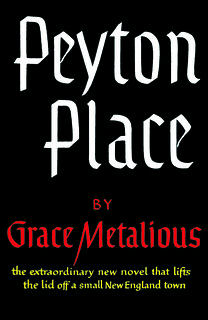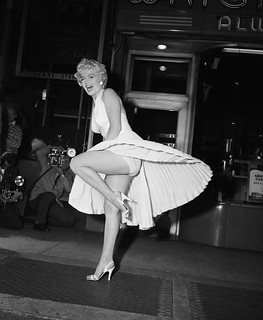Archive for November, 2013
Monster Movies!
by admin - November 20th, 2013
Metalious Place
by admin - November 19th, 2013
 In 1956, Grace Metalious published Peyton Place, a novel that would astonish a nation of people and in addition, bring Metalious a life of infamy. Metalious lived in Gilmanton, New Hampshire; a small town that many have speculated was the source of inspiration for Peyton Place. However, many people do not know the issues Metalious was facing in her own life. Metalious sacrificed relationships with her family members and neglected her own children in order to complete the novel. The townspeople in Gilmanton resented Metalious for writing a book about their personal lives even though no real names were used. The widespread success of Peyton Place was incredibly impressive, and the novel is still discussed today. But was the incredible fame and success of the novel worth the consequences suffered by Grace Metalious for her honest account of small town life in the 1950s? Continue reading →
In 1956, Grace Metalious published Peyton Place, a novel that would astonish a nation of people and in addition, bring Metalious a life of infamy. Metalious lived in Gilmanton, New Hampshire; a small town that many have speculated was the source of inspiration for Peyton Place. However, many people do not know the issues Metalious was facing in her own life. Metalious sacrificed relationships with her family members and neglected her own children in order to complete the novel. The townspeople in Gilmanton resented Metalious for writing a book about their personal lives even though no real names were used. The widespread success of Peyton Place was incredibly impressive, and the novel is still discussed today. But was the incredible fame and success of the novel worth the consequences suffered by Grace Metalious for her honest account of small town life in the 1950s? Continue reading →
Movies of the 1950s
by admin - November 19th, 2013
 One of the things many people picture when they think about the 1950s is teenagers attending drive in movies each week. It turns out that during this decade going to the movies, whether it was at a drive in or an actual theater, was not as popular as it had previously been. McCarthyism played a major role in the lack of movie attendance. “The most publicized assault, and the most difficult to counter because it set workers within the industry against one another, came from allegations of Communist influence in the industry” (Dunar 250.) After beginning to blacklist anyone who they thought to have any communist involvement, executives began only creating movies that they found to be safe and not corrupting to the general public. This meant that many independent films were being made rather than ones directed by well known production companies. This hurt revenue by decreasing about one third from $1.4 billion to $951 million dollars during this decade (Dunar 250.) Continue reading →
One of the things many people picture when they think about the 1950s is teenagers attending drive in movies each week. It turns out that during this decade going to the movies, whether it was at a drive in or an actual theater, was not as popular as it had previously been. McCarthyism played a major role in the lack of movie attendance. “The most publicized assault, and the most difficult to counter because it set workers within the industry against one another, came from allegations of Communist influence in the industry” (Dunar 250.) After beginning to blacklist anyone who they thought to have any communist involvement, executives began only creating movies that they found to be safe and not corrupting to the general public. This meant that many independent films were being made rather than ones directed by well known production companies. This hurt revenue by decreasing about one third from $1.4 billion to $951 million dollars during this decade (Dunar 250.) Continue reading →
Monroe: More Than Just a Pretty Face
by admin - November 19th, 2013
 A woman who defied the stereotypes of her time was Marilyn Monroe. Born as Norma Jean Mortenson in 1926, she grew up in orphanages and foster homes as her mother, Gladys Baker, was institutionalized due to mental illness. Monroe was living with her mother’s best friend, Grace Mckee, while she was nine years old. At this young age, Marilyn was allowed to wear makeup and curl her hair. Once Mckee married, however, Monroe was sent to an orphanage. After the orphanage, she was sent to live with her great aunt Olive Brunings where she was allegedly sexually assaulted by Olive’s son. Many experts question if Monroe’s later behavior such as sleep disturbances, substance abuse, etc. were due to the sexual abuse she encountered during her childhood. At age sixteen, she married a 21-year-old aircraft worker, Jim Dougherty. The couple divorced four years later. It was during this time that Monroe began modeling bathing suits, dyed her hair blonde and began to pose for pin-ups and photos. Continue reading →
A woman who defied the stereotypes of her time was Marilyn Monroe. Born as Norma Jean Mortenson in 1926, she grew up in orphanages and foster homes as her mother, Gladys Baker, was institutionalized due to mental illness. Monroe was living with her mother’s best friend, Grace Mckee, while she was nine years old. At this young age, Marilyn was allowed to wear makeup and curl her hair. Once Mckee married, however, Monroe was sent to an orphanage. After the orphanage, she was sent to live with her great aunt Olive Brunings where she was allegedly sexually assaulted by Olive’s son. Many experts question if Monroe’s later behavior such as sleep disturbances, substance abuse, etc. were due to the sexual abuse she encountered during her childhood. At age sixteen, she married a 21-year-old aircraft worker, Jim Dougherty. The couple divorced four years later. It was during this time that Monroe began modeling bathing suits, dyed her hair blonde and began to pose for pin-ups and photos. Continue reading →
Fast Food in the Fifties
by admin - November 14th, 2013
 With the now widespread use of the automobile, it seemed that everything started to become optimized for cars and ease of use with them. A large part of any country’s culture is their food. It is certainly true that food, and how Americans got it; was now catering to a nation of automobiles. This led to the rise of fast food, and subsequently less frequent usage of sit down restaurants. The fifties were the first decade to see the introduction of drive-thru windows and the first to experience the chain fast food restaurants. Continue reading →
With the now widespread use of the automobile, it seemed that everything started to become optimized for cars and ease of use with them. A large part of any country’s culture is their food. It is certainly true that food, and how Americans got it; was now catering to a nation of automobiles. This led to the rise of fast food, and subsequently less frequent usage of sit down restaurants. The fifties were the first decade to see the introduction of drive-thru windows and the first to experience the chain fast food restaurants. Continue reading →
Just Your Typical American Family
by admin - November 14th, 2013
When you are told to imagine what a typical family household in the fifties looked like, what would you think of? It would certainly not be anything similar to what you would see in today’s society. In today’s society a typical household is one where the kids go off to school and both parents go to work. Now I’m not saying that all families have two working parents but the majority do. Back in the fifties this was not the case. It was the father that would go off to work in the morning and leaving the mother at home with the children. She would cook, clean, and manage the house work every day. Make sure that the fridge is stocked and that all of the kids had done their homework and cleaned up for the day. Continue reading →
Rosa Parks
by admin - November 14th, 2013
 On December 1, 1955 in Montgomery, Alabama, a 42 year old African American woman by the name of Rosa Parks refused to give up her seat on a public bus. This seemingly insignificant decision gave way to an important chain of events that eventually led to the desegregation of public bus systems. I chose to write my blog post about Rosa Parks because I am not only inspired by her actions, but because I am also intrigued by the fact that her one decision brought so many people together to fight for such a monumental cause. Continue reading →
On December 1, 1955 in Montgomery, Alabama, a 42 year old African American woman by the name of Rosa Parks refused to give up her seat on a public bus. This seemingly insignificant decision gave way to an important chain of events that eventually led to the desegregation of public bus systems. I chose to write my blog post about Rosa Parks because I am not only inspired by her actions, but because I am also intrigued by the fact that her one decision brought so many people together to fight for such a monumental cause. Continue reading →
The Highway System
by admin - November 13th, 2013
With the invention of automobiles in the early 20th century, and the rising popularity of them in the 1950s, people in America were on the move. Instead of staying in the cities where they worked, people began to move to neighboring towns. These suburban communities offered many things that city life did not, but convenience and proximity to work was not always one. Commutes to work became longer for the average American, and on slow-paced roads it was surely a hassle.
To remedy this growing issue, president Dwight D. Eisenhower signed a bill into place in 1956 that would create 41,000 miles of interstate highway all across America. Continue reading →
Peyton Place
by admin - November 8th, 2013
I find Peyton Place to be a well written novel, but basically an extreme trying to fight another extreme. Metalious wrote Peyton Place with the stereotype in mind that the fifties was a peaceful, perfect time where families were tightly bonded and everyone got along. She saw the false side to this preconceived notion and did all she could to fight it, in the end not stopping that extreme, but simply creating a new one. Metalious’s work skews our perspective of the fifties, changing it from one of admiration to disgust, when in reality, we just must find room for a version in between the two. Continue reading →

